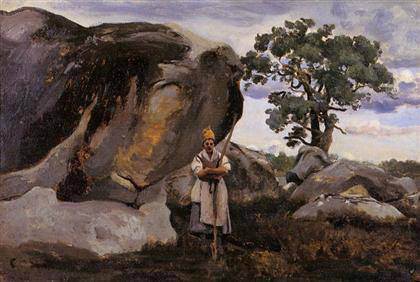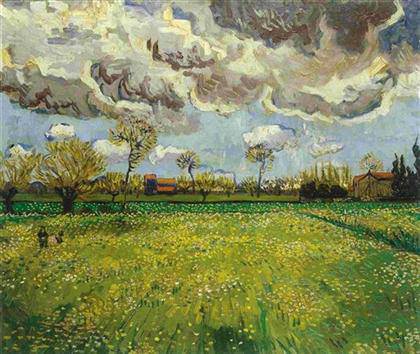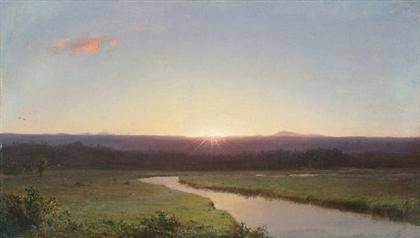
Camille Corot
Paysanne en forêt de Fontainebleau, ca. 1830.
Musée d’Art et d’Archéologie, Senlis.

Vincent van Gogh
Landscape under a stormy sky, 1889
Oil on canvas, 59,5 x 70 cm.
Fondation Socindec
Impressionism & open-air painting. Corot to Van Gogh The exhibition “Impressionism and open‐air Painting. From Corot to Van Gogh” analyses the origins and growth of open‐air painting among the Impressionist painters. Thyssen Museum, 5 February to 12 May 2013.]]>
Source: Thyssen Museum, Madrid
Among the artists represented are pioneers of open‐air oil painting such as Pierre‐Henri Valenciennes and Thomas Jones, in addition to Turner, Constable, Corot, Rousseau, Courbet, Daubigny, Monet, Sisley, Renoir, Seurat, Van Gogh and Cézanne among many other key names.
The exhibition is structured thematically around some of the most frequently depicted motifs in open‐air painting as conceived of by Valenciennes: trees, rocks, streams, etc. Dedicated to one of these themes, each room displays examples of art from different periods and schools with the aim of firstly emphasising the continuity of the tradition of open‐air painting and secondly the diversity of the visual solutions achieved.
1. Ruins, terraces and roofs
In the 18th century, architectural ruins were one of the key elements within landscape painting, giving the work a picturesque character.
2. Rocks
Rocks appear in the earliest examples of landscape paintings. The first separate studies of rocks were painted in Italy in the late 18th century but it was the Barbizon School that made this motif a preeminent one. Towards the end of the 19th century Cézanne returned to the motif of rocksin order to analyse the spatial construction of his works without having to make use of shadow or perspective.
3. Mountains
Mountains were not the subject of aesthetic interest until the 18th century. Among the artists working in Italy, most produced distant views intended as backgrounds for the composition of paintings in the studio. One exception was Vesuvius, which was the subject of numerous depictions.
4. Trees and plants
The practice of executing open‐air studies of the finest and most picturesque trees and plants became widespread in late 18th‐century Italy.
5. Waterfalls, lakes, streams and rivers
Water added variety and freshness to the composition, as seen in the earliest examples of landscape paintings onwards. Among the Impressionists it was Monet who paid most attention to the changing effects of water.
6. Skies and clouds
The depiction of the sky was a subject of interest to art theoreticians since the time of Leonardo. This room concludes with examples by Van Gogh and Nolde, both of whom had a stylised, subjective and almost abstract conception of clouds.
7. The sea
Like mountains, the sea was contemplated with fear until the 18th century. While some Neo‐classical painters produced outdoor sea studies on the Gulf of Naples, it was once again Constable who was responsible for the first important examples painted outdoors. Among the Impressionists, Monet was particularly attracted to the sea.
Related content
Impressionism: Sensation & Inspiration in Amsterdam (exhibition, 2012)
Follow us on:


